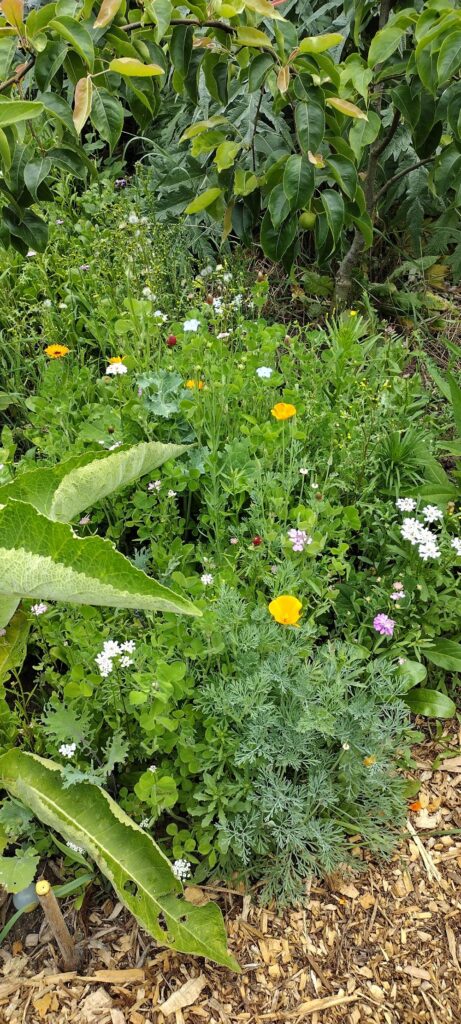I hadn’t heard about chaos gardening until recently, but it turns out that I’ve always been a chaotic gardener. It’s a label that I am happy to adopt! It’s a unique and liberating approach to gardening that I have found to be fun, rewarding, and much easier than traditional methods. Chaos gardening is about embracing the wild and unpredictable nature of plants, and allowing them to grow in a more natural and unstructured manner. Chaos gardening also allows for more experimentation and forgiveness when things don’t go as planned.

What is Chaos Gardening?
There aren’t any hard and fast rules. One of the great things about chaos gardening is that you can do what works best for you! Seeds are sown and plants are placed without strict organization. Plant spacing rules may be ignored. You may want to plant flowers next to vegetables, next to herbs. You might scatter a variety of seeds across your garden, mix them together in beds, or plant them randomly throughout your space. This method often mimics natural ecosystems, where plants grow in diverse, intermingled communities. The result is a lush, vibrant, and often surprising garden where different plants attract beneficial insects, and create a beautiful, biodiverse environment.

Why Choose Chaos Gardening?
Chaos gardening can be an excellent choice for those looking to simplify their gardening routine, save time and money, and embrace a more relaxed approach to cultivating plants. To me, chaos gardening feels a lot easier and less stressful than more traditional methods. Here are a few reasons why someone might want to become a chaos gardener:
- Low Maintenance: Chaos gardening means less weeding because the dense planting helps keep the weeds down. Plus, a mix of different plants helps keep pests at bay. This is a big deal for me because I have this stubborn grass in my yard that just won’t quit—it spreads everywhere!
- Biodiversity: When you plant a bunch of different species together, you boost the biodiversity in your garden. This makes your garden ecosystem stronger and also supports local wildlife, like bees and butterflies.
- Surprises and Joy: The best part about chaos gardening is the surprises. You never know exactly what will thrive or where different plants will pop up. This unpredictability can bring a sense of wonder and joy to your gardening experience. It’s so much fun to see what grows!
- Sustainability: Chaos gardening is great for the environment because it mimics natural growth patterns and cuts down on the need for synthetic stuff. It helps you create a more harmonious relationship with nature and fosters a healthier environment.
How I do Chaos Gardening
My method of chaos gardening relies on intuition. I gather plants and seeds, and I plant them where it feels like they should go. Sometimes this works really well, and sometimes I just get a jumble of miscellaneous plants. I am trying to be more mindful about what type of lighting a plant needs, and I try to amend the soil as I’m able to.
A basic way to start chaos gardening, is to simply gather a variety of seeds and plants that you would like to grow. These can include vegetables, herbs, flowers, and even wildflowers. Scatter the seeds over your prepared garden bed, lightly rake them into the soil, and water them well. Dig a hole and place the plants where it seems like they may thrive the best. Then, let nature take its course. Observe how the plants grow and interact with each other, and enjoy the beauty of a garden that evolves in unexpected ways. Be ready for some plants not to thrive, and embrace the chaos.

I do have a few guidelines that I generally follow on the homestead. First, I have a raised bed section. In the raised beds, I only plant annuals- mostly fruits and vegetables that I can plant in a succession to have produce as long in the year as possible. I also include annual flowers like nasturtiums and marigolds to help with pest control.
In general, for the in-ground beds, the priorities are:
1. perennial food bearing plants
2. perennial culinary and medicinal herbs
3. perennial flowers
Around the house, I do focus more on the flowers because I want to be able to sit on my patio and be surrounded by flowers. In all the other beds, I stick to my priorities.
What I love the most about being a chaotic gardener is how low stress it is. If something doesn’t work out, I either try again, or I try something else. It reduces my stress if a plant doesn’t do well. Chaos gardening helps me create a vibrant and diverse garden, it allows me to celebrate the unpredictability of nature, and makes gardening a much more enjoyable activity. I highly encourage you to embrace the wild, and see what wonders your garden can produce!





